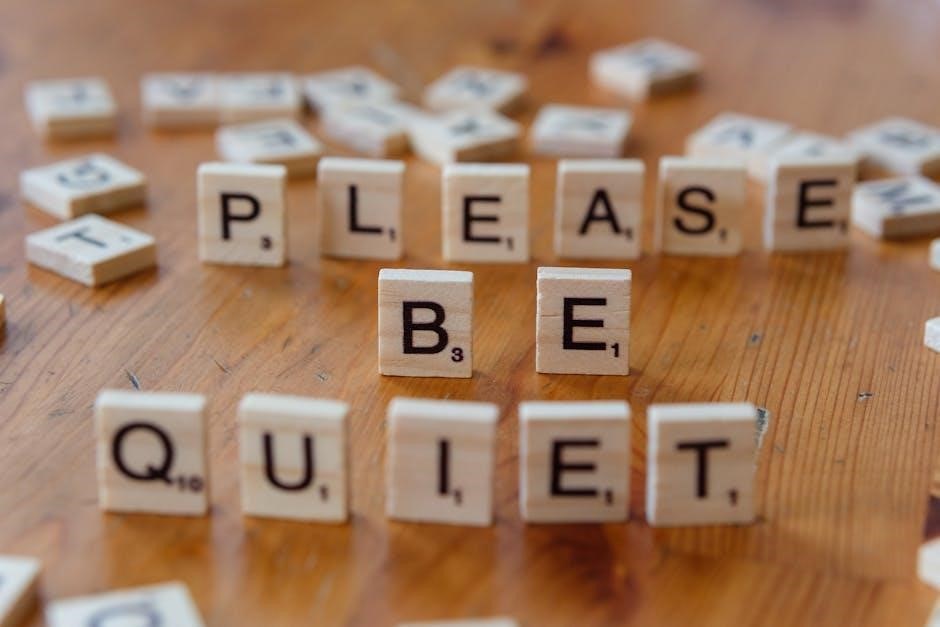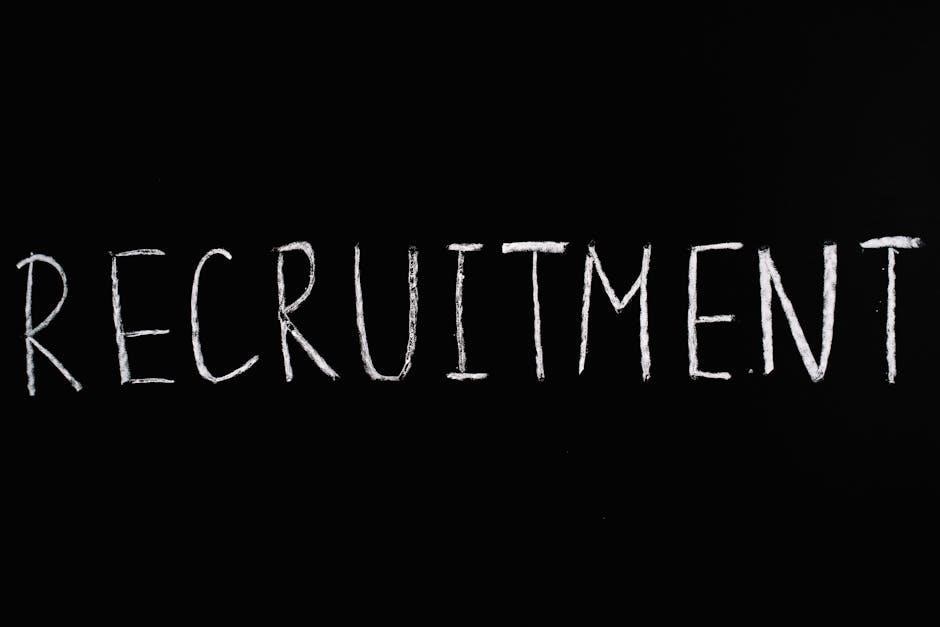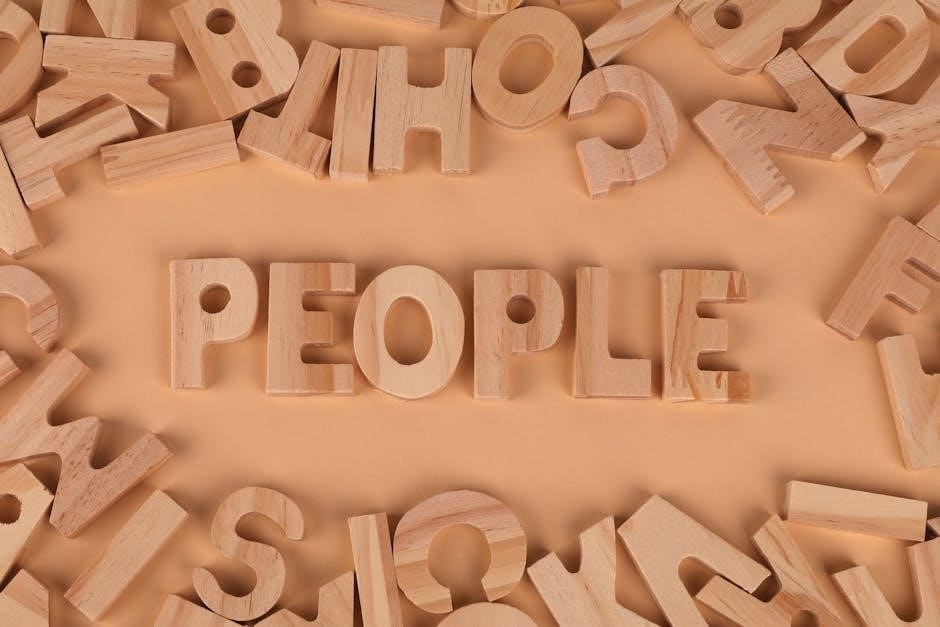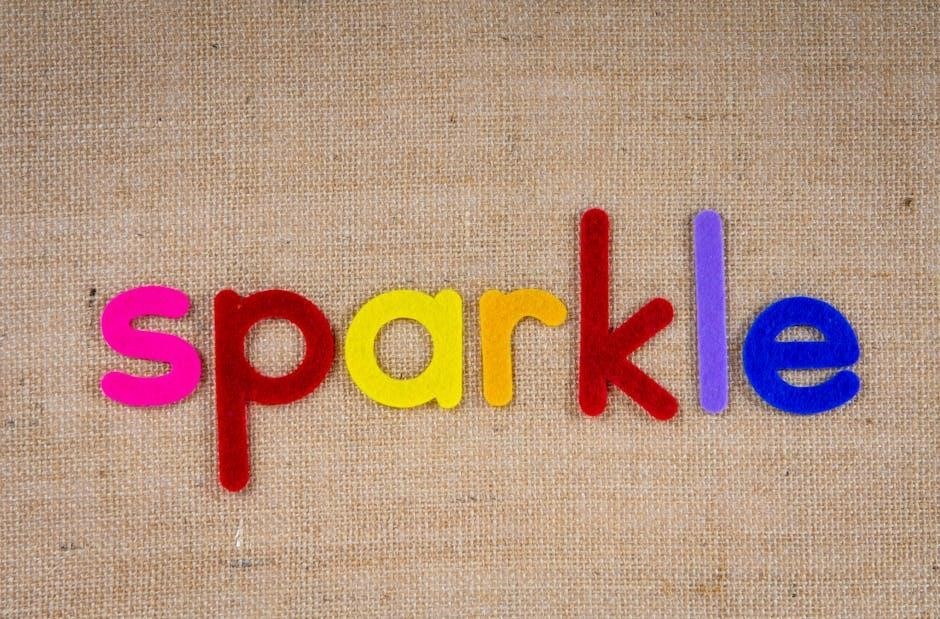
The manual alphabet‚ a cornerstone of sign language‚ enables communication through handshapes representing letters. Free PDF resources‚ like charts and flashcards‚ simplify learning and practicing fingerspelling‚ empowering individuals to connect across languages and cultures effectively.
Overview of Sign Language
Sign language is a visual and tactile means of communication that uses handshapes‚ facial expressions‚ and body gestures to convey meaning. It is not a universal language‚ as it varies across regions and cultures. The manual alphabet‚ a fundamental component of sign language‚ allows individuals to spell words letter by letter‚ enabling communication when specific signs are unknown. This system is invaluable for fingerspelling names‚ places‚ and terms without direct sign equivalents. Resources like free PDF charts and guides simplify learning‚ making sign language accessible to everyone.
Importance of the Manual Alphabet
The manual alphabet is a vital tool for communication in sign language‚ enabling individuals to spell words and names when specific signs are unknown. It is particularly crucial for proper nouns‚ such as names‚ places‚ and titles‚ ensuring clarity in conversations. Free PDF resources‚ including charts and flashcards‚ make learning the manual alphabet accessible and engaging. These tools are invaluable for beginners‚ fostering inclusivity and bridging communication gaps between hearing and deaf communities. Mastery of the manual alphabet empowers individuals to connect effectively‚ enhancing both personal and professional interactions.

History of the Sign Language Alphabet
The manual alphabet traces its roots to medieval musical notation systems‚ evolving over centuries to become a standardized tool for communication. Its design reflects historical influences and practical refinements.
Origins and Evolution
The manual alphabet’s origins trace back to medieval systems‚ influenced by Guido Aretinus’s musical notation. Over centuries‚ it evolved into a standardized tool for communication‚ particularly in deaf education. Initially‚ two-handed systems were common‚ but many countries‚ like the U.S.‚ adopted one-handed signing for efficiency. This adaptation allowed for smoother integration into daily communication‚ enabling individuals to fingerspell words and names effectively. The modern sign language alphabet reflects a blend of historical influences and practical refinements‚ making it a vital component of sign language systems worldwide.

Benefits of Learning the Sign Language Alphabet
Mastering the sign language alphabet enhances communication‚ bridges cultural gaps‚ and boosts cognitive skills. It empowers individuals to connect with the deaf community and fosters inclusive understanding.
Empowerment of Deaf and Hard-of-Hearing Individuals
Learning the sign language alphabet fosters self-expression and confidence among deaf and hard-of-hearing individuals. It enables effective communication‚ breaking down barriers and fostering inclusivity. Access to free PDF resources‚ such as charts and flashcards‚ makes learning accessible and engaging‚ allowing deaf individuals to fully participate in both deaf and hearing communities. This empowerment strengthens their ability to connect‚ share ideas‚ and thrive in diverse social and professional settings‚ promoting equality and understanding.
Bridging Communication Between Cultures
The sign language alphabet acts as a universal bridge‚ fostering understanding between diverse cultures. Despite regional variations‚ such as one-handed in the U.S. and two-handed in Australia and the UK‚ these systems enable cross-cultural exchange. Free PDF resources‚ like charts and guides‚ make learning accessible‚ helping individuals connect with deaf communities worldwide. By mastering these alphabets‚ people can transcend language barriers‚ promoting inclusivity and empathy. This shared tool not only aids communication but also enriches cultural exchanges‚ highlighting the unity within diversity of global sign languages.
Cognitive Benefits and Enhanced Memory
Learning the sign language alphabet enhances cognitive skills‚ particularly memory and dexterity. The process of associating handshapes with letters sharpens recall abilities‚ while repetitive practice strengthens neural pathways. Fingerspelling‚ a core component of sign language‚ boosts visual and motor memory‚ aiding in retaining sequences and patterns; Free PDF resources‚ such as flashcards and charts‚ provide structured tools for effective memorization. This mental and physical engagement fosters improved concentration and problem-solving skills‚ making sign language learning a holistic cognitive exercise that extends beyond mere communication.
How to Learn the Sign Language Alphabet
Mastering the sign language alphabet begins with free PDF guides‚ offering clear handshape visuals and step-by-step instructions. Utilize flashcards and video tutorials for interactive learning‚ reinforcing daily practice through real-life application and consistent drills to build proficiency and confidence.
Step-by-Step Guide to Mastering the Alphabet
Begin by downloading a free PDF chart of the sign language alphabet‚ which provides visual representations of each letter. Start with handshapes for common letters like A‚ B‚ and C‚ ensuring correct finger placement and palm orientation. Practice challenging letters such as J and Z‚ which require specific movements. Use flashcards to test recognition and improve memory. Incorporate daily practice by fingerspelling words‚ names‚ and phrases. Apply letters in real-life scenarios‚ like grocery lists or menus‚ to enhance retention and practical use of the manual alphabet.
Practicing Difficult Letters
Mastering challenging letters like J‚ Z‚ and Q requires focused practice. For J‚ trace the letter in the air after forming the I handshape. Z involves creating a number 1 handshape and drawing the letter. Letters C and F can be tricky due to similar handshapes; practice with fingers apart for F to avoid strain. M‚ N‚ and T are easily confused‚ so pay attention to thumb placement. Use mirrors to check handshapes and practice sequences like J-Z or P-Q to build muscle memory. Regular practice ensures these letters become second nature.

Resources for Learning the Sign Language Alphabet
Free PDF downloads‚ such as charts and flashcards‚ provide visual guides for learning. Video tutorials and online courses offer interactive lessons‚ making it easier to master the alphabet.
Free PDF Downloads and Printables
Free PDF downloads offer high-quality visual guides for learning the sign language alphabet. These resources include charts‚ flashcards‚ and coloring pages‚ designed to engage learners of all ages. Printable sign language alphabet posters are ideal for classrooms or personal use‚ providing a quick reference for fingerspelling. Additionally‚ interactive PDFs allow users to practice receptive memory by matching letters with handshapes. These materials are easily accessible and provide a structured approach to mastering the manual alphabet‚ making learning both fun and effective for beginners and advanced learners alike.
Video Tutorials and Online Courses
Video tutorials and online courses provide a structured approach to learning the sign language alphabet. These resources offer step-by-step lessons‚ practice exercises‚ and interactive quizzes to enhance retention. Platforms like Start ASL offer free courses that cover the manual alphabet and beyond‚ ensuring learners grasp handshapes and grammar. Many tutorials include real-life applications‚ helping users understand how to integrate fingerspelling into daily communication. These tools are invaluable for those seeking a comprehensive and engaging learning experience‚ making sign language accessible to everyone.

Differences in Sign Language Alphabets Across Countries
Sign language alphabets vary globally‚ with one-handed systems in the U.S. and two-handed systems in Australia and the U.K.‚ reflecting cultural and linguistic diversity.
One-Handed vs. Two-Handed Alphabets
Sign language alphabets differ in handedness globally. American Sign Language (ASL) uses a one-handed system‚ with each letter represented by unique handshapes‚ enhancing clarity and efficiency‚ especially for fingerspelling. In contrast‚ countries like Australia and the UK employ two-handed alphabets‚ such as Auslan and British Sign Language (BSL)‚ which may offer visibility and expressiveness. This distinction impacts communication between users of different sign languages‚ necessitating adaptation for effective interaction. While ASL resources are abundant‚ two-handed systems may require more effort to learn‚ reflecting cultural and historical influences in their development.
Examples from Australia‚ the UK‚ and the US
Australia uses Auslan‚ employing a two-handed manual alphabet‚ with each letter formed by specific handshapes and orientations. The UK’s British Sign Language (BSL) also uses a two-handed system‚ reflecting regional linguistic variations. In contrast‚ American Sign Language (ASL) in the US utilizes a one-handed alphabet‚ with distinct handshapes for each letter. These differences highlight cultural and historical influences‚ with resources like PDF charts available for each‚ aiding learners in understanding and adapting to these unique systems for effective communication across borders and languages.

Why Learning the Sign Language Alphabet is Essential
Mastering the sign language alphabet empowers communication with the deaf community‚ fostering inclusivity and understanding. It bridges gaps‚ enabling effective interaction and connection across linguistic and cultural barriers.
Fingerspelling and Its Applications
Fingerspelling‚ using handshapes to represent letters‚ is crucial for communication in sign language. It allows individuals to spell names‚ brand names‚ and words without signs. This method is especially useful for proper nouns and unknown terms. Free PDF resources‚ like charts and flashcards‚ facilitate learning and practicing these handshapes‚ enhancing both expressive and receptive skills. Fingerspelling bridges communication gaps‚ enabling interactions in various settings‚ from classrooms to daily conversations. It is an essential tool for connecting with the deaf community and fostering inclusivity in communication.
Motor Skill Development and Hand Shapes
Mastering the sign language alphabet requires precise handshapes and finger placements‚ enhancing motor skills and dexterity. Each letter demands specific finger positions‚ strengthening hand muscles and improving coordination. For example‚ letters like “C” and “F” involve distinct handshapes‚ while “M” and “N” rely on thumb placement. Free PDF guides provide visual aids for accurate formation‚ ensuring learners develop the necessary muscle memory. Regular practice helps refine these skills‚ making communication clearer and more effective. This process fosters both physical dexterity and linguistic competence‚ essential for fluent sign language use.
Overcoming Memory and Dexterity Issues
Learning the sign language alphabet can present challenges‚ especially with memory retention and hand dexterity. Breaking the alphabet into smaller groups and practicing regularly helps build confidence. Using memory aids‚ such as associating handshapes with familiar objects‚ can enhance retention. Difficult letters like “J” and “Z‚” which require motion‚ benefit from slow‚ controlled practice. Flashcards and coloring pages‚ available in free PDFs‚ provide engaging ways to reinforce learning. Consistent practice strengthens motor skills and improves recall‚ making the process enjoyable and rewarding for learners of all ages.

Technology in Sign Language Recognition
Advancements in computer vision and machine learning have revolutionized sign language recognition‚ enabling accurate hand gesture interpretation. These technologies enhance communication and learning‚ making sign language more accessible globally.
Computer Vision and Machine Learning Advances
Computer vision and machine learning have significantly enhanced sign language recognition‚ enabling accurate interpretation of hand gestures and finger spelling. These technologies use cameras to capture handshapes and movements‚ which are then analyzed by algorithms to identify corresponding letters or words. Recent advancements‚ such as deep learning models‚ have improved accuracy‚ achieving over 90% recognition rates for sign language alphabets. This innovation opens doors for real-time translation tools‚ making communication more accessible for deaf and hard-of-hearing individuals. Such systems also aid in teaching and learning sign languages‚ bridging the gap between spoken and visual communication effectively.

Effective Practice Techniques
Using flashcards and real-life scenarios enhances learning. Practice regularly with charts‚ exercises‚ and interactive tools to improve retention and dexterity in signing the alphabet accurately.
Using Flashcards and Real-Life Scenarios
Flashcards are an excellent tool for practicing sign language letters‚ helping to improve both memory and recognition. Real-life scenarios‚ such as grocery shopping or ordering coffee‚ provide practical contexts for applying fingerspelling skills. Additionally‚ resources like printable flashcards and interactive PDFs offer engaging ways to reinforce learning. Incorporating activities such as coloring pages and wallpapers further enhances retention‚ making the process fun and accessible for learners of all ages. These methods ensure that learning the sign language alphabet is both effective and enjoyable.

Frequently Asked Questions
Where can I find free sign language alphabet PDFs? Resources like StartASL and LessonTutor offer downloadable charts and worksheets. These tools aid in learning fingerspelling and basic communication effectively.
Addressing Common Queries About the Alphabet
Common questions about the sign language alphabet often revolve around its availability and use. Many ask‚ “Where can I find free PDF resources?” Websites like StartASL and LessonTutor offer downloadable charts and worksheets. Others inquire about the differences between one-handed and two-handed alphabets‚ with the U.S. using one hand and countries like Australia and the UK using two. Additionally‚ learners frequently ask how to practice effectively‚ with flashcards and real-life applications being recommended. These queries highlight the alphabet’s essential role in communication and its variations across cultures.

Future Developments in Sign Language
Advancements in technology‚ such as AI and machine learning‚ are enhancing sign language learning. Integrated tools with PDF resources promise more accessible and interactive educational experiences for learners.
Integration of Technology for Enhanced Learning
Technology is revolutionizing sign language education through interactive tools and AI-driven platforms. Free PDF resources‚ video tutorials‚ and apps now incorporate machine learning to recognize and correct handshapes in real-time. Augmented reality (AR) apps overlay digital handshapes onto users’ hands‚ providing immediate feedback. These innovations make learning the manual alphabet more accessible and engaging. By leveraging technology‚ learners can practice anytime‚ anywhere‚ with personalized feedback. This integration not only enhances memory retention but also bridges gaps in traditional learning methods‚ fostering a more inclusive and dynamic educational experience for all.